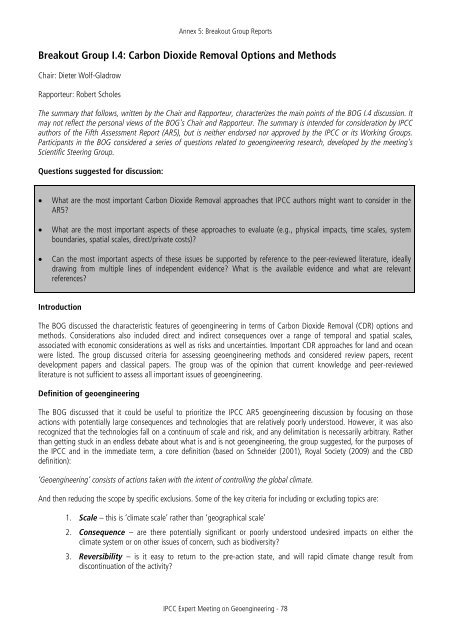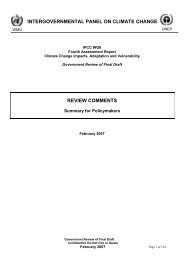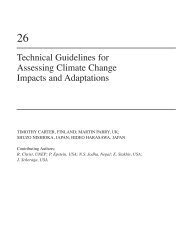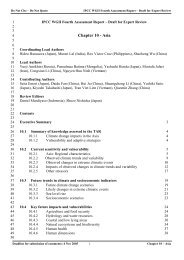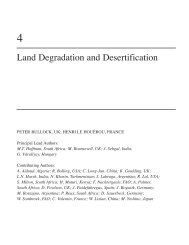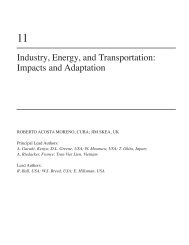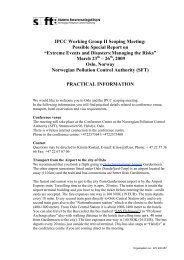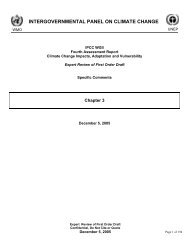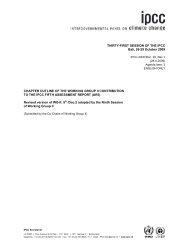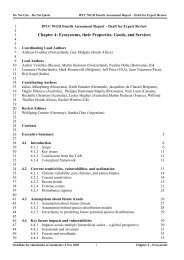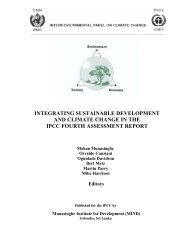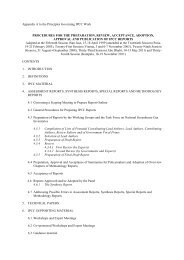IPCC Expert Meeting on Geoengineering
IPCC Expert Meeting on Geoengineering
IPCC Expert Meeting on Geoengineering
Create successful ePaper yourself
Turn your PDF publications into a flip-book with our unique Google optimized e-Paper software.
Annex 5: Breakout Group Reports<br />
Breakout Group I.4: Carb<strong>on</strong> Dioxide Removal Opti<strong>on</strong>s and Methods<br />
Chair: Dieter Wolf-Gladrow<br />
Rapporteur: Robert Scholes<br />
The summary that follows, written by the Chair and Rapporteur, characterizes the main points of the BOG I.4 discussi<strong>on</strong>. It<br />
may not reflect the pers<strong>on</strong>al views of the BOG’s Chair and Rapporteur. The summary is intended for c<strong>on</strong>siderati<strong>on</strong> by <str<strong>on</strong>g>IPCC</str<strong>on</strong>g><br />
authors of the Fifth Assessment Report (AR5), but is neither endorsed nor approved by the <str<strong>on</strong>g>IPCC</str<strong>on</strong>g> or its Working Groups.<br />
Participants in the BOG c<strong>on</strong>sidered a series of questi<strong>on</strong>s related to geoengineering research, developed by the meeting’s<br />
Scientific Steering Group.<br />
Questi<strong>on</strong>s suggested for discussi<strong>on</strong>:<br />
<br />
<br />
<br />
What are the most important Carb<strong>on</strong> Dioxide Removal approaches that <str<strong>on</strong>g>IPCC</str<strong>on</strong>g> authors might want to c<strong>on</strong>sider in the<br />
AR5?<br />
What are the most important aspects of these approaches to evaluate (e.g., physical impacts, time scales, system<br />
boundaries, spatial scales, direct/private costs)?<br />
Can the most important aspects of these issues be supported by reference to the peer-reviewed literature, ideally<br />
drawing from multiple lines of independent evidence? What is the available evidence and what are relevant<br />
references?<br />
Introducti<strong>on</strong><br />
The BOG discussed the characteristic features of geoengineering in terms of Carb<strong>on</strong> Dioxide Removal (CDR) opti<strong>on</strong>s and<br />
methods. C<strong>on</strong>siderati<strong>on</strong>s also included direct and indirect c<strong>on</strong>sequences over a range of temporal and spatial scales,<br />
associated with ec<strong>on</strong>omic c<strong>on</strong>siderati<strong>on</strong>s as well as risks and uncertainties. Important CDR approaches for land and ocean<br />
were listed. The group discussed criteria for assessing geoengineering methods and c<strong>on</strong>sidered review papers, recent<br />
development papers and classical papers. The group was of the opini<strong>on</strong> that current knowledge and peer-reviewed<br />
literature is not sufficient to assess all important issues of geoengineering.<br />
Definiti<strong>on</strong> of geoengineering<br />
The BOG discussed that it could be useful to prioritize the <str<strong>on</strong>g>IPCC</str<strong>on</strong>g> AR5 geoengineering discussi<strong>on</strong> by focusing <strong>on</strong> those<br />
acti<strong>on</strong>s with potentially large c<strong>on</strong>sequences and technologies that are relatively poorly understood. However, it was also<br />
recognized that the technologies fall <strong>on</strong> a c<strong>on</strong>tinuum of scale and risk, and any delimitati<strong>on</strong> is necessarily arbitrary. Rather<br />
than getting stuck in an endless debate about what is and is not geoengineering, the group suggested, for the purposes of<br />
the <str<strong>on</strong>g>IPCC</str<strong>on</strong>g> and in the immediate term, a core definiti<strong>on</strong> (based <strong>on</strong> Schneider (2001), Royal Society (2009) and the CBD<br />
definiti<strong>on</strong>):<br />
‘<strong>Geoengineering</strong>’ c<strong>on</strong>sists of acti<strong>on</strong>s taken with the intent of c<strong>on</strong>trolling the global climate.<br />
And then reducing the scope by specific exclusi<strong>on</strong>s. Some of the key criteria for including or excluding topics are:<br />
1. Scale – this is ‘climate scale’ rather than ‘geographical scale’<br />
2. C<strong>on</strong>sequence – are there potentially significant or poorly understood undesired impacts <strong>on</strong> either the<br />
climate system or <strong>on</strong> other issues of c<strong>on</strong>cern, such as biodiversity?<br />
3. Reversibility – is it easy to return to the pre-acti<strong>on</strong> state, and will rapid climate change result from<br />
disc<strong>on</strong>tinuati<strong>on</strong> of the activity?<br />
<str<strong>on</strong>g>IPCC</str<strong>on</strong>g> <str<strong>on</strong>g>Expert</str<strong>on</strong>g> <str<strong>on</strong>g>Meeting</str<strong>on</strong>g> <strong>on</strong> <strong>Geoengineering</strong> - 78


